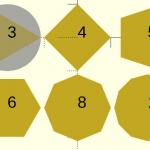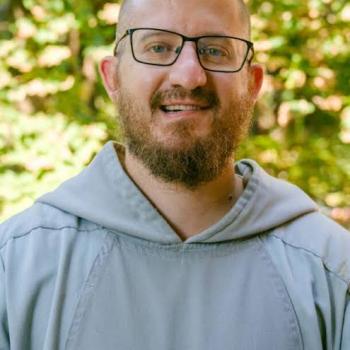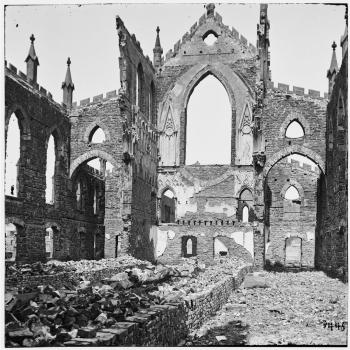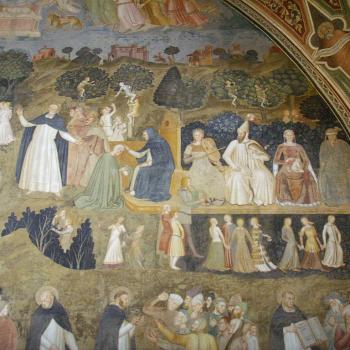 Arians questioned the divinity of Jesus Christ. They said that the Son, by being begotten, was a created being, and that there was a time in which the Son was not. In debate after debate with Arius and the Arians, St. Athanasius emphasized the divinity of Jesus Christ; discussions of the incarnation, and how to portray it, was not entirely worked out.
Arians questioned the divinity of Jesus Christ. They said that the Son, by being begotten, was a created being, and that there was a time in which the Son was not. In debate after debate with Arius and the Arians, St. Athanasius emphasized the divinity of Jesus Christ; discussions of the incarnation, and how to portray it, was not entirely worked out.
At the time of Athanasius, there was no talk about Jesus as being “two natures in one person.” This developed would come later and made official through the efforts of Pope St. Leo and the Council of Chalcedon. Athanasius was able to work with Apollinaris against the Arians because they two agreed on the divinity of Jesus Christ. Only when it was clear that Apollinaris’ notion of the incarnation was deficient because he denied the complete and perfect humanity of Jesus Christ by denying Jesus’s soul did Athanasius reject the teachings of his former ally. Athanasius eventually had to convene a synod and condemn Apollinaris’s Christological views, because Athanasius understood that God becoming man took on the whole of humanity and all that it entailed to be human including a human soul.
Athanasius certainly went into exile many times as a result of his conflict with the Arians. It was not over the explanation of how and why Jesus is said to be God and man, and it especially was not because he gave a Chalcedonian explanation for the incarnation. To suggest that Athanasius present the incarnation with Chalcedonian vocabulary would be absurd. This is why I am somewhat surprised that such a basic historical error was given by Cardinal Burke in a reply to LifeSiteNews:
One has only to remember how Saint Athanasius, for example, was exiled for defending the truth of the two natures in the one Divine Person of Our Lord.
This is not to say that St. Athanasius was unorthodox in his theological view, but his notions were not as sophisticated as we would find in theological investigations after Chalcedon. The difference between person and nature was not distinguished so that in the anathemas of the Nicene Creed, it was said that those who said the Son was a different hypostasis or ousia from the Father were anathema. Christological and Trinitarian vocabulary later developed to help clarify what is meant by person and nature so that the persons of the Trinity could be distinguished while affirming their unity; St. Athanasius would never have said “two natures in one divine person” because of his understanding of “person” and “nature” differed from what the Cappadocian Fathers and their theological successors established in relation to the concepts of hypostasis and ousia.
It is very easy to believe oneself to be the lone hero fighting against apostasy in the church. Not even Athanasius thought of himself in such terms, because he understood such individualistic self-promotion countered the whole meaning of the church and tradition. It is easy to assume the church is wrong when we disagree with it, making ourselves the judge of the church instead of listening to the work of the Holy Spirit in the church itself. Indeed, to think of oneself as the heroic champion the church needs to fix the church from all its errors comes out of pride; it neglects to consider the possibility we are the ones wrong. We end up with a spirit which denies the church, which denies the inspiration of the Holy Spirit in the church as we turn ourselves into an oracle which must be listened to and believed over against the church as a whole. This spiritual delusion not only leads to schism, but outright heresy. Each and every heretic thought themselves as being above the church, and that their own private interpretation of theology and history was able to overrule the teachings of the church in their own day, forgetting the wise rule of Scripture: “do not rely on your own insight” (Prov. 3:5b RSV).
Arius, Nestorius, Eutyches, Leo III the Isaurian, Savronola, Martin Luther, and many others like them, thought they were upholding the tradition of the church and teaching it based upon what they understood, not willing to change their view when the church’s theological reasoning and self-understanding developed. Some of what they said might have been true, but it was not complete; they became imprisoned with a literal emphasis of past theological narratives without understanding the meaning intended by them, which is why they were not able to recognize and accept the greater truth being presented by the church.
Likewise, we find so-called traditionalists employing the same self-reliance and literalistic rigorism rejecting the church today. They claim their understanding of the church and its theological legacy is greater than the Spirit inspiring the church today. If they wanted us to believe their claim, it would at least be helpful if they could demonstrate theological competence, understanding and explaining the basics of the history of Christian theology right. If they want to be seen in the light of St. Athanasius, they would be best to understand St. Athanasius, his teaching, and the conflicts he faced as a result of his beliefs. If they cannot get that right, then we can see how and why it is incredible and absurd for us to follow them in their declarations of the greater and more complex theological and pastoral guidelines of the church. They fight the church with their own limited understanding and of course, as with everyone else like them in the past, their words will end up being footnotes in history as the church continues to teach and preach what the Spirit inspires her to teach.
[Image=Athanasius at Nicea by Anonymous [Public domain], via Wikimedia Commons]
Stay in touch! Like A Little Bit of Nothing on Facebook















